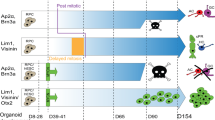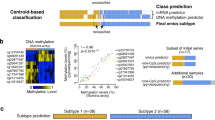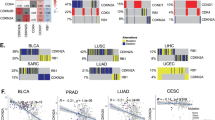Abstract
Retinoblastoma, the most common intraocular tumour of childhood, probably arises from embryonal cells and occurs in hereditary and non-hereditary forms1. Recent evidence suggests that this retinoblastoma (Rb) susceptibility gene located at chromosome 13q14 is actually recessive2–4. Knudson has proposed that the tumour is caused by two mutational events5. This idea was extended by Comings6, who suggested that dominantly inherited tumours may resuit from loss or inactivation of both alleles of regulatory or suppressor genes that, when active, prevent the expression of a structural transforming gene(s) (possibly an oncogene) normally active only during embryogenesis. Despite circumstantial evidence3,4,7,8for this hypothesis, no activated oncogene9–14 has been identified. We now report that (1) the N-myc gene is amplified 10–200-fold in two primary retinoblastomas and a retinoblastoma cell line Y79 and (2) expression of N-myc gene is highly elevated in most of the retinoblastomas examined. This finding suggests that N-myc gene may have a primary role in the turaorigenesis of retinoblastoma.
This is a preview of subscription content, access via your institution
Access options
Subscribe to this journal
Receive 51 print issues and online access
$199.00 per year
only $3.90 per issue
Buy this article
- Purchase on Springer Link
- Instant access to full article PDF
Prices may be subject to local taxes which are calculated during checkout
Similar content being viewed by others
References
Murphree, A. L. & Benedict, W. F. Science 223, 1028–1033 (1984).
Sparkes, R. S. et al. Science 219, 971–973 (1983).
Benedict, W. F. et al. Science 219, 973–975 (1983).
Cavenee, W. et al. Nature 305, 779–784 (1983).
Knudson, A. G. Proc. natn. Acad. Sci. U.S.A. 68, 820–823 (1971).
Comings, D. E. Proc. natn. Acad. Sci. U.S.A. 70, 3324–3328 (1973).
Godbout, R., Dryja, T. P., Squire, J., Gallie, B. I. & Phillips, R. A. Nature 304, 451–453 (1983).
Benedict, W. F., Banerjee, A., Mark, C. & Murphree, A. L. Cancer Genet. Cytogenet. 8, 311–333 (1983).
Cooper, G. M. Science 218, 801–806 (1983).
Bishop, J. M. A. Rev. Biochem. 52, 301–354 (1983).
Santos, E., Tronick, S. R., Aaronson, S. A., Pulciani, S. & Barbacid, M. Nature 298, 343 (1982).
Land, H., Parada, L. A. & Weinberg, R. A. Science 222, 771–778 (1983).
Leder, P. et al. Science 222, 765–771 (1983).
Perucho, M. et al. Cell 27, 467 (1981).
Southern, E. M. J. molec. Biol. 98, 503–517 (1975).
Lee, W.-H., Liu, C.-P. & Duesberg, P. H. J. Virol. 44, 401–412 (1982).
Schwab, M. et al. Nature 305, 245–248 (1983).
Kohl, N. Z. et al. Cell 35, 359–367 (1983).
Schimke, R. T. (ed.) Gene Amplification (Cold Spring Harbor Laboratory, New York, 1983).
White, B. & Bancroft, F. J. biol. Chem. 257, 8569–8572 (1982).
Brodeur, G. M., Seeger, R. C., Schwab, M., Varmus, H. E. & Bishop, J. M. Science (in the press).
Kyritsis, A. P., Tsokos, M., Triche, T. J. & Chader, G. J. Nature 307, 471–473 (1984).
Yunis, J. J. Science 221, 227–236 (1983).
Koufos, A. et al. Nature 309, 170–172 (1984).
Maniatis, T., Fritsch, E. F. & Sambrook, J. Molecular Cloning, A Laboratory Manual (Cold Spring Harbor Laboratory, New York, 1982).
Author information
Authors and Affiliations
Rights and permissions
About this article
Cite this article
Lee, WH., Murphree, A. & Benedict, W. Expression and amplification of the N-myc gene in primary retinoblastoma. Nature 309, 458–460 (1984). https://doi.org/10.1038/309458a0
Received:
Accepted:
Issue Date:
DOI: https://doi.org/10.1038/309458a0
This article is cited by
-
Inhibition of high level E2F in a RB1 proficient MYCN overexpressing chicken retinoblastoma model normalizes neoplastic behaviour
Cellular Oncology (2024)
-
Mouse models of pediatric high-grade gliomas with MYCN amplification reveal intratumoral heterogeneity and lineage signatures
Nature Communications (2023)
-
SMARCE1 promotes neuroblastoma tumorigenesis through assisting MYCN-mediated transcriptional activation
Oncogene (2022)
-
MYCN induces cell-specific tumorigenic growth in RB1-proficient human retinal organoid and chicken retina models of retinoblastoma
Oncogenesis (2022)
-
Syngeneic leukemia models using lentiviral transgenics
Cell Death & Disease (2021)
Comments
By submitting a comment you agree to abide by our Terms and Community Guidelines. If you find something abusive or that does not comply with our terms or guidelines please flag it as inappropriate.



